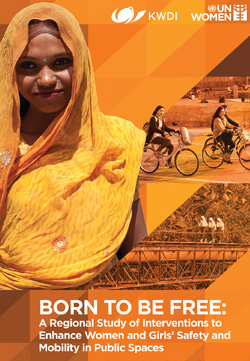
BORN TO BE FREE

A Regional Study of Interventions to Enhance Women and Girls’ Safety and Mobility in Public Spaces, Asia and the Pacific Region
In public and private spaces, women and girls experience and fear various types of violence, ranging from harassment, to rape and femicide. Momentum is growing around the issue of women and girls’ safety in urban, public spaces. However, given that this is a relatively new field of work, published evidence of the impacts of such interventions remain somewhat scattered and limited. The UN Women Asia-Pacific Regional Office, with support from the Korean Women’s Development Institute, identified the need to bring together the collective body of knowledge and build on lessons learned from promising practices. Doing so will result in evidence-based recommendations for programmatic and policy entry points to bolster investment in the region.
The review included 55 evaluated interventions, a survey of over 118 stakeholders working on the issue globally, over 50 in-depth interviews and field visits to Jakarta, Indonesia; Hanoi and Ho Chi Minh City, Viet Nam; and Seoul, Republic of Korea. The review found that there is an inconsistent understanding of the root causes of VAWG in public spaces. There is often a failure to see violence against women in the urban public space as part of a larger continuum of violence against women and girls, which limits cross-cutting and holistic solutions in addressing the causes of sexual violence. Nevertheless, there are certain promising approaches. The highly participatory and explicitly feminist interventions from the global UN Women Safe Cities programme, among others, show great promise in their inclusion of women from the community to take up leadership roles in the safe cities movement. Moreover, comprehensive school-based interventions have shown some success in targeting harmful gender norms that are the root causes of sexual harassment and violence. Quite a few interventions have been designed to train bystanders on how to intervene in situations of harassment, although the findings from such interventions are mixed.
Recommendations point to the need to address violence against women and girls at every sectoral level and in a coordinated way, involving different actors and stakeholders, and the use of a gender-transformative lens that sees women as agents of their own destiny. To maximize effectiveness, interventions must also take an inclusive approach, targeting marginalized and vulnerable groups. In addition, there is an urgent need to address the paucity and low quality of evaluations. Lastly, interventions should target women’s mobility and not just their safety. An excessive focus on safety is protectionist, narrow and moves away from the revolutionary conceptual framework set up by the safe cities movement. As one of the key informants stated, “a heighted sense of danger is not helping their independence so we really need to be addressing the underlying causes of violence against women.”